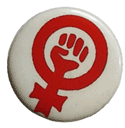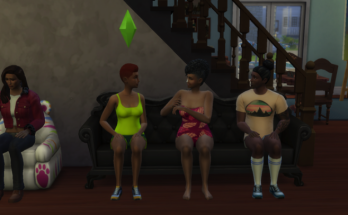Through the course of the semester in MALS 72200: Contemporary Feminist Thought at The Graduate Center, City University of New York, we have debated and analyzed what are safe, democratic, feminist online spaces (ideally, of color), while looking for tools and elements that allows us to look for and even create those spaces for ourselves. Having reached the final part of my project, I’ve realized that the answer depends on each individual: in other words, there is no such thing as one unified idea of what constitutes a safe online place. As my initial proposal evolved and moved from Unruly Bodies to Medium.com as a platform that contained safe elements where I could debate these topics, my interests and questions did the same. By interacting with TS – first her commenting on my posts[1], then by email, and ultimately by listening to her intervention – I realized that my original concern on the representations of Latinas in online spaces extended also to how bodies of color/ethnicity are depicted, shown and performed in social media. From here, I decided that the best way to bring the online debate that I’ve had with TS and create my own X-Reality to my Real Life set was by reach out to people in the (literal) outside world.
For my part of the assignment, the method used for this final piece of the project was a local, micro ethnography of women (white and of color) in Union Square and Washington Square Parks. In TS’ case, and because she explicitly said that she did not comfortable exposing herself outside her limits (let alone with strangers), she asked if she could do the same but with her female colleagues from her workplace. I agreed with her, and let her know that she was free to ask anything the wanted regarding the topics we have already mentioned before in our interactions, and any other matter that she would like to address as well. Because, as we have discussed, these spaces work differently when hierarchies and/or harsh guidelines are established, I wanted to make this as free as possible for her, just to see what could be her outcome.
Initially, I thought that interacting with strangers outside my known community would have been easier than doing it with the one online; I was, however, terribly mistaken, for I was completely out of my comfort zone. Nevertheless, and against my preliminary apprehensions, the experience turned out to be extremely fulfilling and eye-opening, since I was able to socialize directly with small groups of women, most of them of color. In total, I was able to interview five Black women – divided in groups of three and two – three South Asian/Indian women, four White women, and five Asians[2], all of them young adults between 20 and 35 years old. On and off the record, all of them (with the exception of White girls) identified themselves as being American + their race (ex. African-American, Asian-American), and all of them (with the exception of the South Asian mother)
Regarding the questions posed, I decided to switch between these main three: do you identify as a woman of color? Do you think there are online safe places for women and women of color? How do you think race impacts the representation of women’s (of color) bodies in social media and media? The most common answer was that women of color were not equally depicted in SM, and that they are usually stereotypes of their own race. Among this, the following[3] were for me the most relevant ideas that came out from their answers, and that made me re-think about these spaces, and my role as a woman, and as a feminist in them:
- Black women: (black) girls are used as props for other’s entertainment; the lighter the skin is, the prettier women are considered by brands and photographers, and therefore that’s the main narrative; bigger (black) women are considered sluts; there is no real solution for online misrepresentation
- Indian (South Asian) women: what is the definition of safe? Safety is different depending on each woman; who is in power behind these spaces? Who creates them, and for whom?; spaces can be safe as long as there is not derogative language in them
- Asian (Korean) women: Asian women are misrepresented and placed as aliens, sometimes dirty, nerds, with usual perfect skin and skinny bodies; there are spaces that they can’t claim because they feel like it belongs to Black girls in a rightful way; in terms of safety, they believed gender comes before race: a place can be unsafe for a woman precisely because of her gender, regardless of the color of her skin
- White women: one of the biggest issues is that representations of women’s bodies online are white (ads follow that same pattern); privacy means safety.
In general, all girls of color agreed that there are (safe*) places online where they can go and interact with others while feeling more validated and represented in the same ways they perform IRL; in this aspect, those spaces tended to be primarily focused on POC, confirming what Coleman (2011) establishes when she discusses how realities can be augmented thanks to technology and the possibilities that it gives to extend the ways in which individuals interact beyond physical limits. It was also interesting noticing that except for one, none of them really identified themselves as feminists, nor questioned feminism as a premise for these definitions of safe spaces; on this, I wonder if Benet-Weiser was on the right track by proposing that “feminism is “popular” [and] manifests in discourses and practices that are circulated in popular and commercial media, such as digital spaces like blogs, Instagram, and Twitter.” (1, 2018), making of feminism and its uses elements that are taken by granted, or simply dismissed.
On the other hand, TS’s part was done on a smaller scale. Even though she did not really address much of what we had previously discussed in our interactions, she did question if the internet was a place where women of color/ethnicity would feel represented, and the little space that queer women in general have in these spaces. As our exchanges were mostly based on the performed body of Latinas on the internet, gender identity was left apart from our conversation and from my own research, a mistake that made me realize that my take of my space (my blog) and my questions are not completely democratic nor inclusive yet. While being interviewed by one of her co-workers, TS mentioned a few ideas that are also mentioned by Gray (2009) regarding how queer youth look for access and sites on the internet instead than their own real spaces, for it is within the virtual world where they (on TS’ opinion) have been able to find a niche; however, she observes that in terms of online and media representation, queer women are usually represented either as the femme or lanky, if not masculine. Regarding the results of her intervention, here are the primary ideas and answers that caught my attention, and that I find relevant for the ongoing discussion:
- Women of color, if represented online and in media, are portrayed and painted lighter (light washed) than what they actually look like.
- Latinas are represented with the ideal of the “hot, tanned, curvy-yet-skinny” bodies.
- Hispanics is a term that was created here in the US to denominate everyone who speaks Spanish, regarding their background or ethnicity.
- Those women interviewed that identify themselves as White/European descendant, believe that in general American females are depicted online and in mass media as uneducated and uncultured, whereas British, French and Spanish ones are portrayed in a better light (more refined and cultured).
Contrary to what I was hoping for, the outcomes of this exploration failed to address directly the issue of safe spaces AND race; nevertheless, the result was still rich for it allowed me to observe the difficulties of interacting with someone else whilst doing the same thing in the off line world, with the same fluidity and easiness that the Internet allows. Following what TS did, and out of curiosity, I challenged two of my co-workers who are Mexican-American and Dominican to reply a few of the questions here proposed, and the answers were in some ways similar to the ones I’ve mentioned already, with the addition that in general, Latinas’ bodies are presented as less discrete, open to the gaze, and always under the idea that they need to go through hardships in order to become successful and recognized.
On a final note, I personally decided to take one step further and bring my own findings back to my initial safe space, which has been Instagram for the last few years. By posting a selfie exposing more parts of my body than what I am used to , I identified and described myself in hopes to spark some debate regarding my definition of a safe and democratic online space; apart from the number of likes (way more than what I thought), the answers provided by some of my close friends reflected some of the concerns that we share as women, but also as Latinas. Overall, for them there is no such thing as one definition of what it means to be a Latina, but there is an evaluation in terms of how we look like, and how we are treated as a “second category” the darker our skin is. At the same time, they agreed that being a Latina means being hyper-sexualized “to the point of parody”, and that no matter what skin tone or ethnicity we claim, the projection of the body (the stereotyped one) will always prevail over any other category. In other words, there is still a negative version of ourselves as Latinxs that not only comes from media, but within inside the community as well.
What was the most fascinating finding out of this experience is that my idea of an ideal democratic online space transferred to the real world, and not the other way around. It is safe to say that, as we have mentioned over the semester, ultimately one universal safe democratic space of color online is hard to create and achieve. In order to accomplish this, creators and participants need to engage civically online and out of it; at the same time, and as Soep (2016) proposes, the stories and narratives used need to be appealing for our target audience with tools and platforms that are designed with them in mind. For the case of my own project and desires, it needs to be a place that includes not just women of color, but also sections where each can feel represented and voiced without the threat of feeling diminished or stereotyped; a free, accessible space where there are no hierarchies, yet with rules of engagement between users, and with the option to remain private if they decide so.
[1] I would like to make a brief aside on this part: by an apparent copyright issue, my Medium section has been temporarily disabled and a couple posts were taken down by, I am assuming, the moderators of the platform. I reached out to the site but I have yet to hear back from them.
[2] Ironically, I was not able to find one single Latina in either of my searches, thus why they were not included in this part; however, TS was more successful and was able to interview one of her colleagues, who is an Ecuadorian-Puerto Rican woman.
[3] To make it even clearer, I organized the answers according to each group, to also allow a better understanding of how race shapes the demands, wishes and exclusions between these women, and how concords with their views on race and gender.

